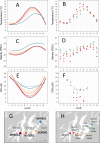Long-term changes in kelp forests in an inner basin of the Salish Sea
- PMID: 33596204
- PMCID: PMC7888675
- DOI: 10.1371/journal.pone.0229703
Long-term changes in kelp forests in an inner basin of the Salish Sea
Abstract
Kelp forests form an important biogenic habitat that responds to natural and human drivers. Global concerns exist about threats to kelp forests, yet long-term information is limited and research suggests that trends are geographically distinct. We examined distribution of the bull kelp Nereocystis luetkeana over 145 years in South Puget Sound (SPS), a semi-protected inner basin in a fjord estuary complex in the northeast Pacific Ocean. We synthesized 48 historical and modern Nereocystis surveys and examined presence/absence within 1-km segments along 452 km of shoreline. Compared to the earliest baseline in 1878, Nereocystis extent in 2017 decreased 63%, with individual sub-basins showing up to 96% loss. Losses have persisted for decades, across a range of climate conditions. In recent decades, Nereocystis predominantly occurred along shorelines with intense currents and mixing, where temperature and nutrient concentrations did not reach thresholds for impacts to Nereocystis performance, and high current speeds likely excluded grazers. Losses predominated in areas with elevated temperature, lower nutrient concentrations, and relatively low current velocities. The pattern of long-term losses in SPS contrasts with stability in floating kelp abundance during the last century in an area of the Salish Sea with greater wave exposure and proximity to oceanic conditions. These findings support the hypothesis that kelp beds along wave-sheltered shorelines exhibit greater sensitivity to environmental stressors. Additionally, shorelines with strong currents and deep-water mixing may provide refugia within sheltered systems.
Conflict of interest statement
The authors have declared that no competing interests exist.
Figures





Similar articles
-
Winter oceanographic conditions predict summer bull kelp canopy cover in northern California.PLoS One. 2022 May 5;17(5):e0267737. doi: 10.1371/journal.pone.0267737. eCollection 2022. PLoS One. 2022. PMID: 35511813 Free PMC article.
-
Factors influencing recruitment and appearance of bull kelp, Nereocystis luetkeana (phylum Ochrophyta).J Phycol. 2019 Feb;55(1):236-244. doi: 10.1111/jpy.12814. Epub 2018 Dec 18. J Phycol. 2019. PMID: 30565227
-
Effects of temperature and nutrients on microscopic stages of the bull kelp (Nereocystis luetkeana, Phaeophyceae).J Phycol. 2023 Oct;59(5):893-907. doi: 10.1111/jpy.13366. Epub 2023 Jul 27. J Phycol. 2023. PMID: 37497792
-
Threats and knowledge gaps for ecosystem services provided by kelp forests: a northeast Atlantic perspective.Ecol Evol. 2013 Oct;3(11):4016-38. doi: 10.1002/ece3.774. Epub 2013 Sep 15. Ecol Evol. 2013. PMID: 24198956 Free PMC article. Review.
-
High-latitude kelps and future oceans: A review of multiple stressor impacts in a changing world.Ecol Evol. 2023 Jul 4;13(7):e10277. doi: 10.1002/ece3.10277. eCollection 2023 Jul. Ecol Evol. 2023. PMID: 37408620 Free PMC article. Review.
Cited by
-
A century of canopy kelp persistence and recovery in the Gulf of Alaska.Ann Bot. 2024 Mar 8;133(1):105-116. doi: 10.1093/aob/mcad149. Ann Bot. 2024. PMID: 37832150 Free PMC article.
-
Automated satellite remote sensing of giant kelp at the Falkland Islands (Islas Malvinas).PLoS One. 2022 Jan 6;17(1):e0257933. doi: 10.1371/journal.pone.0257933. eCollection 2022. PLoS One. 2022. PMID: 34990455 Free PMC article.
-
Ammonification by kelp associated microbes increases ammonium availability.PLoS One. 2024 Mar 29;19(3):e0296622. doi: 10.1371/journal.pone.0296622. eCollection 2024. PLoS One. 2024. PMID: 38551914 Free PMC article.
-
Feeding preferences and the effect of temperature on feeding rates of the graceful kelp crab, Pugettia gracilis.PeerJ. 2023 Apr 21;11:e15223. doi: 10.7717/peerj.15223. eCollection 2023. PeerJ. 2023. PMID: 37101789 Free PMC article.
-
Spatial organization of the kelp microbiome at micron scales.Microbiome. 2022 Mar 24;10(1):52. doi: 10.1186/s40168-022-01235-w. Microbiome. 2022. PMID: 35331334 Free PMC article.
References
-
- Graham HM. Effects of local deforestation on the diversity and structure of southern California giant kelp forest food webs. Ecosystems. 2004;7(4):341–57.
-
- Pratchett MS, Hoey A, Wilson S. Reef degradation and the loss of critical ecosystem goods and services provided by coral reef fishes. Current Opinion in Environmental Sustainability. 2014;7:37–43.
-
- Steneck RS, Graham MH, Bourque BJ, Corbett D, Erlandson JM, Estes JA, et al. Kelp forest ecosystems: biodiversity, stability, resilience and future. Environmental Conservation. 2002;29(04):436–59. 10.1017/S0376892902000322 - DOI
-
- Wernberg T, Krumhansl K, Filbee-Dexter K, Pedersen MF. Chapter 3—Status and Trends for the World’s Kelp Forests In: Sheppard C, editor. World Seas: an Environmental Evaluation (Second Edition): Academic Press; 2019. p. 57–78.
Publication types
MeSH terms
LinkOut - more resources
Full Text Sources
Other Literature Sources

